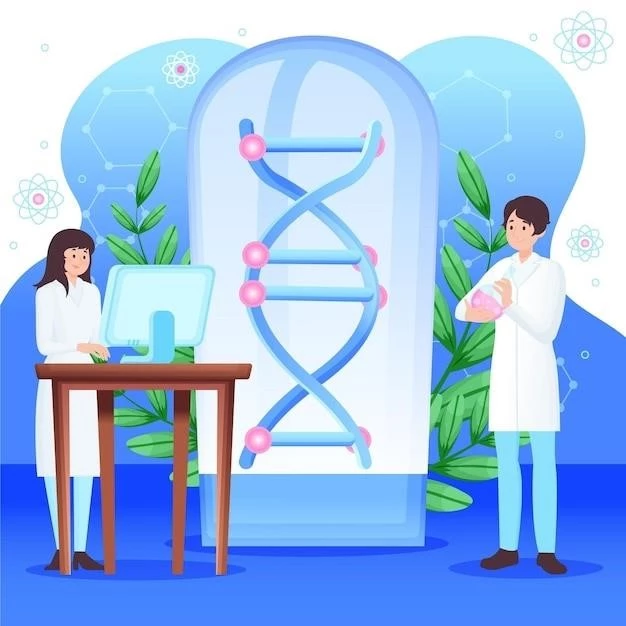Juvenile Hyaline Fibromatosis (JHF)
Disease⁚ Juvenile Hyaline Fibromatosis
Learn about the rare genetic disorder JHF caused by mutations in the ANTXR2 gene. It affects fibrous tissue‚ causing skin lesions‚ joint contractures‚ nodules‚ gum hyperplasia‚ restrictive pulmonary disease‚ short stature. It manifests in early childhood and follows an autosomal recessive pattern.
Overview of Juvenile Hyaline Fibromatosis
Juvenile Hyaline Fibromatosis (JHF) is a rare genetic disorder characterized by mutations in the ANTXR2 gene. This condition primarily affects the connective tissue‚ leading to the formation of abnormal hyaline deposits in various parts of the body.
Individuals with JHF often develop skin lesions‚ joint contractures‚ nodules‚ and gum hyperplasia. Additionally‚ they may experience restrictive pulmonary disease‚ which can impact breathing. The disorder typically presents in early childhood‚ with symptoms progressing over time.
JHF follows an autosomal recessive pattern of inheritance‚ meaning that both parents must carry a copy of the mutated gene for a child to inherit the condition. Due to the genetic nature of the disorder‚ individuals with a family history of JHF are at an increased risk of passing it on to their children.
As JHF primarily affects fibrous tissue‚ it can lead to physical limitations such as short stature and joint stiffness. Understanding the genetic basis of this condition is crucial for diagnosis and management‚ as targeted treatments can help alleviate symptoms and improve quality of life for individuals with JHF.

Genetic Basis of JHF
Juvenile Hyaline Fibromatosis (JHF) is caused by mutations in the ANTXR2 gene‚ which provides instructions for making a protein involved in the extracellular matrix. The abnormal gene function leads to the accumulation of hyaline material in various tissues of the body.
These mutations are inherited in an autosomal recessive pattern‚ meaning that individuals must inherit two copies of the mutated gene (one from each parent) to develop the disorder. Carriers of a single mutated gene are typically unaffected but can pass the gene on to their offspring.
Genetic testing is essential for diagnosing JHF‚ as identifying the specific mutations in the ANTXR2 gene can confirm the presence of the disorder. Understanding the genetic basis of JHF not only aids in diagnosis but also plays a vital role in genetic counseling for affected individuals and their families.
Researchers continue to study the genetic mechanisms underlying JHF to improve diagnostic methods and explore potential targeted therapies. By unraveling the genetic basis of this condition‚ scientists aim to develop more effective treatments that address the root cause of JHF and improve outcomes for individuals living with this rare genetic disorder.
Clinical Features of JHF
Juvenile Hyaline Fibromatosis (JHF) presents with a variety of clinical features that primarily involve the skin‚ joints‚ and other tissues affected by the abnormal accumulation of hyaline material. Common manifestations of JHF include skin lesions‚ which may appear as papules or nodules‚ and can vary in size and distribution.
Individuals with JHF may also experience joint contractures‚ leading to limited mobility and range of motion in the affected joints. This can result in physical discomfort and challenges with daily activities. Gum hyperplasia‚ characterized by overgrowth of gum tissue‚ is another common feature of JHF that can impact oral health and aesthetics.
Some individuals with JHF develop short stature due to the effects of the condition on bone growth and development. Additionally‚ restrictive pulmonary disease may occur in some cases‚ causing breathing difficulties and reduced lung function. These respiratory issues can significantly impact overall well-being and quality of life.
Recognizing the clinical features of JHF is crucial for early detection and management of the disorder. Healthcare providers should be knowledgeable about the characteristic signs and symptoms of JHF to facilitate timely diagnosis and appropriate intervention to address the various challenges individuals with this condition may face.
Complications Associated with JHF
Individuals with Juvenile Hyaline Fibromatosis (JHF) may experience a range of complications related to the progressive nature of the disorder and the impact of abnormal hyaline deposits on various tissues. One common complication is the development of joint contractures‚ which can lead to stiffness and reduced mobility in the affected joints.
Skin lesions‚ including nodules and papules‚ may cause discomfort and affect the individual’s appearance. Gum hyperplasia‚ characterized by excessive growth of gum tissue‚ can result in dental issues and difficulty with oral hygiene. These complications can impact the individual’s quality of life and require ongoing management.
Restrictive pulmonary disease‚ a complication of JHF‚ can lead to breathing difficulties and decreased lung function. Individuals may experience shortness of breath‚ fatigue‚ and respiratory distress‚ affecting their daily activities and overall well-being. It is essential to monitor respiratory function closely and provide appropriate support to manage these complications.
Other potential complications of JHF include skeletal abnormalities contributing to short stature‚ which may impact growth and development. Early recognition and proactive intervention to address complications associated with JHF are crucial in promoting optimal health outcomes and enhancing the quality of life for individuals living with this rare genetic disorder.
Diagnosis of Juvenile Hyaline Fibromatosis
Diagnosing Juvenile Hyaline Fibromatosis (JHF) involves a comprehensive evaluation of the patient’s clinical symptoms‚ family history‚ and genetic testing; Healthcare providers will assess the presence of characteristic signs of JHF‚ such as skin lesions‚ joint contractures‚ nodules‚ and gum hyperplasia.
Genetic testing plays a crucial role in confirming a diagnosis of JHF by identifying mutations in the ANTXR2 gene. This specialized testing helps differentiate JHF from other related conditions with similar symptoms‚ ensuring an accurate diagnosis and appropriate management plan.
Imaging studies‚ such as X-rays and MRIs‚ may be used to evaluate joint abnormalities‚ skeletal changes‚ and organ involvement associated with JHF. Biopsies of affected tissues can provide additional information about the nature of hyaline deposits and aid in confirming the diagnosis.
Given the rare nature of JHF‚ healthcare providers with expertise in genetic disorders and connective tissue conditions are essential for the accurate diagnosis and management of this complex disorder. Collaborating with a multidisciplinary team can ensure comprehensive care and support for individuals with Juvenile Hyaline Fibromatosis.
Treatment Options for JHF
Management of Juvenile Hyaline Fibromatosis (JHF) focuses on addressing the symptoms and complications associated with the disorder to improve the quality of life for affected individuals. While there is no cure for JHF‚ various treatment options aim to alleviate discomfort and manage complications.
Medical interventions may include surgical procedures to address joint contractures or skin nodules that impact mobility or cause pain. Physical therapy and occupational therapy can help maintain joint flexibility and function‚ as well as improve overall strength and mobility.
Management of gum hyperplasia often involves dental care and regular monitoring by a dentist or oral health specialist. Respiratory support‚ such as supplemental oxygen or breathing exercises‚ may be necessary for individuals with restrictive pulmonary disease to improve lung function.
Regular monitoring by healthcare providers is crucial to track disease progression‚ manage complications‚ and adjust treatment strategies as needed. Genetic counseling can provide valuable information and support for individuals and families regarding the hereditary nature of JHF.
Supportive care and a multidisciplinary approach involving healthcare professionals from various specialties‚ including genetics‚ dermatology‚ pulmonology‚ and orthopedics‚ can help individuals with JHF effectively manage their condition and enhance their overall well-being.
Prognosis and Long-Term Outlook
The prognosis for individuals with Juvenile Hyaline Fibromatosis (JHF) varies depending on the severity of symptoms‚ complications‚ and response to treatment. While JHF is a chronic condition without a cure‚ early detection and timely intervention can help manage the disorder and improve outcomes.
Individuals with JHF may experience challenges related to joint stiffness‚ skin lesions‚ respiratory issues‚ and other complications that can impact daily living. However‚ with appropriate medical care‚ physical therapy‚ and supportive interventions‚ many individuals with JHF can lead fulfilling lives.
Regular monitoring by healthcare providers and adherence to treatment plans are essential for managing the progression of JHF and addressing associated complications. Genetic counseling can provide valuable guidance for individuals and families regarding the genetic implications of the disorder.
While JHF can present lifelong challenges‚ advances in medical research and treatment options offer hope for improved quality of life for individuals living with this rare genetic disorder. Maintaining a proactive approach to healthcare and collaborating with a knowledgeable healthcare team can positively influence the long-term outlook for individuals affected by JHF.
Supportive Care and Resources for JHF Patients
Supportive care and access to resources play a crucial role in enhancing the well-being of individuals with Juvenile Hyaline Fibromatosis (JHF) and their families. Seeking out specialized healthcare providers who are knowledgeable about rare genetic disorders like JHF can provide tailored support and guidance.
Support groups and online communities dedicated to JHF can offer valuable emotional support‚ shared experiences‚ and information on coping strategies. Connecting with others facing similar challenges can help individuals feel less isolated and more empowered in managing their condition.
Accessing reliable information from reputable sources‚ such as medical organizations and genetic clinics‚ can help individuals with JHF and their caregivers make informed decisions about treatment options‚ genetic testing‚ and long-term care plans. Education and advocacy are key components of navigating the complexities of living with a rare genetic disorder like JHF.
Collaborating with a multidisciplinary healthcare team that may include geneticists‚ dermatologists‚ pulmonologists‚ and physical therapists can ensure comprehensive care and ongoing support for individuals with JHF. Developing a personalized care plan that addresses the unique needs and challenges of each individual is essential for promoting optimal health outcomes and quality of life.
Conclusion
In conclusion‚ Juvenile Hyaline Fibromatosis (JHF) is a rare genetic disorder with diverse clinical manifestations that primarily affect fibrous tissues in the body. Understanding the genetic basis of JHF‚ including mutations in the ANTXR2 gene‚ is essential for accurate diagnosis and tailored treatment approaches.
Managing JHF requires a multidisciplinary approach involving healthcare professionals from various specialties to address the complex needs of individuals with this condition. While there is no cure for JHF‚ proactive management of symptoms‚ regular monitoring‚ and supportive care can significantly improve the quality of life for affected individuals.
Accessing reliable information‚ support groups‚ and specialized resources can empower individuals with JHF and their families to navigate the challenges associated with the disorder. By staying informed‚ connected‚ and proactive in seeking appropriate care‚ individuals living with JHF can optimize their long-term outlook and well-being.
Advancements in medical research and genetic therapies offer hope for future treatments that may further enhance outcomes for individuals with JHF. By continuing to raise awareness‚ promote advocacy‚ and prioritize holistic care for individuals with rare genetic disorders like JHF‚ we can collectively work towards improving the lives of those affected by these conditions.
